check engine light YAMAHA XV1900A 2013 Owners Manual
[x] Cancel search | Manufacturer: YAMAHA, Model Year: 2013, Model line: XV1900A, Model: YAMAHA XV1900A 2013Pages: 88, PDF Size: 1.75 MB
Page 6 of 88

TABLE OF CONTENTSSAFETY INFORMATION ..................1-1
DESCRIPTION ..................................2-1
Left view ..........................................2-1
Right view ........................................2-2
Controls and instruments.................2-3
INSTRUMENT AND CONTROL
FUNCTIONS .......................................3-1
Immobilizer system .........................3-1
Main switch/steering lock ................3-2
Indicator lights and warning lights ..............................3-4
Multi-function meter unit .................3-5
Handlebar switches ......................3-10
Clutch lever ...................................3-11
Shift pedal .....................................3-12
Brake lever ...................................3-12
Brake pedal ..................................3-12
Fuel tank cap ................................3-13
Fuel ...............................................3-13
Fuel tank breather/ overflow hose ............................3-15
Catalytic converter ........................3-15
Rider seat .....................................3-16
Helmet holder ...............................3-16
Adjusting the shock absorber assembly ...................................3-17
EXUP system ...............................3-19
Sidestand ......................................3-19
Ignition circuit cut-off system ........3-20 Auxiliary DC connector ................. 3-22
FOR YOUR SAFETY –
PRE-OPERATION CHECKS ............. 4-1
OPERATION AND IMPORTANT
RIDING POINTS ................................. 5-1
Starting the engine ......................... 5-1
Shifting ........................................... 5-2
Tips for reducing fuel consumption ............................... 5-3
Engine break-in .............................. 5-3
Parking ........................................... 5-4
PERIODIC MAINTENANCE AND
ADJUSTMENT ................................... 6-1
Owner’s tool kit ............................... 6-2
Periodic maintenance chart for the
emission control system ............. 6-3
General maintenance and
lubrication chart .......................... 6-4
Checking the spark plugs ............... 6-8
Engine oil and oil filter cartridge ..... 6-9
Transfer case oil ........................... 6-12
Air filter element ........................... 6-12
Checking the throttle grip free play ............................. 6-13
Valve clearance ............................ 6-13
Tires ............................................. 6-13
Cast wheels .................................. 6-15
Clutch lever .................................. 6-15 Checking the brake
lever free play ........................... 6-16
Brake light switches ..................... 6-16
Checking the front and rear brake pads ................................ 6-17
Checking the brake and clutch fluid levels ...................... 6-17
Changing the brake and
clutch fluids ............................... 6-19
Drive belt slack ............................ 6-19
Checking and lubricating the cables ................................. 6-20
Checking and lubricating the throttle grip and cable ............... 6-20
Checking and lubricating the brake and shift pedals .............. 6-21
Checking and lubricating the
brake and clutch levers ............ 6-21
Checking and lubricating the sidestand ............................ 6-22
Lubricating the rear suspension ... 6-22
Checking the front fork ................. 6-23
Checking the steering .................. 6-23
Checking the wheel bearings ....... 6-24
Battery ......................................... 6-24
Replacing the fuses ..................... 6-25
Replacing a headlight bulb .......... 6-26
Tail/brake light ............................. 6-29
Replacing a turn signal light bulb ................................... 6-29
License plate light ........................ 6-29U1CRE2E0.book Page 1 Monday, September 17, 2012 9:05 AM
Page 12 of 88

SAFETY INFORMATION
1-5
1tor and may limit control ability,
therefore, such accessories are
not recommended.
●
Use caution when adding electri-
cal accessories. If electrical acces-
sories exceed the capacity of the
motorcycle’s electrical system, an
electric failure could result, which
could cause a dangerous loss of
lights or engine power.
Aftermarket Tires and Rims
The tires and rims that came with your
motorcycle were designed to match the
performance capabilities and to provide
the best combination of handling, brak-
ing, and comfort. Other tires, rims, siz-
es, and combinations may not be
appropriate. Refer to page 6-13 for tire
specifications and more information on
replacing your tires.
Transporting the Motorcycle
Be sure to observe following instruc-
tions before transporting the motorcy-
cle in another vehicle.
●
Remove all loose items from the
motorcycle.
●
Check that the fuel cock (if
equipped) is in the “OFF” position
and that there are no fuel leaks.
●
Point the front wheel straight
ahead on the trailer or in the truck
bed, and choke it in a rail to pre-
vent movement.
●
Shift the transmission in gear (for
models with a manual transmis-
sion).
●
Secure the motorcycle with tie-
downs or suitable straps that are
attached to solid parts of the mo-
torcycle, such as the frame or up-
per front fork triple clamp (and not,
for example, to rubber-mounted
handlebars or turn signals, or parts
that could break). Choose the lo-
cation for the straps carefully so
the straps will not rub against
painted surfaces during transport.
●
The suspension should be com-
pressed somewhat by the tie-
downs, if possible, so that the mo-
torcycle will not bounce excessive-
ly during transport.
U1CRE2E0.book Page 5 Monday, September 17, 2012 9:05 AM
Page 19 of 88
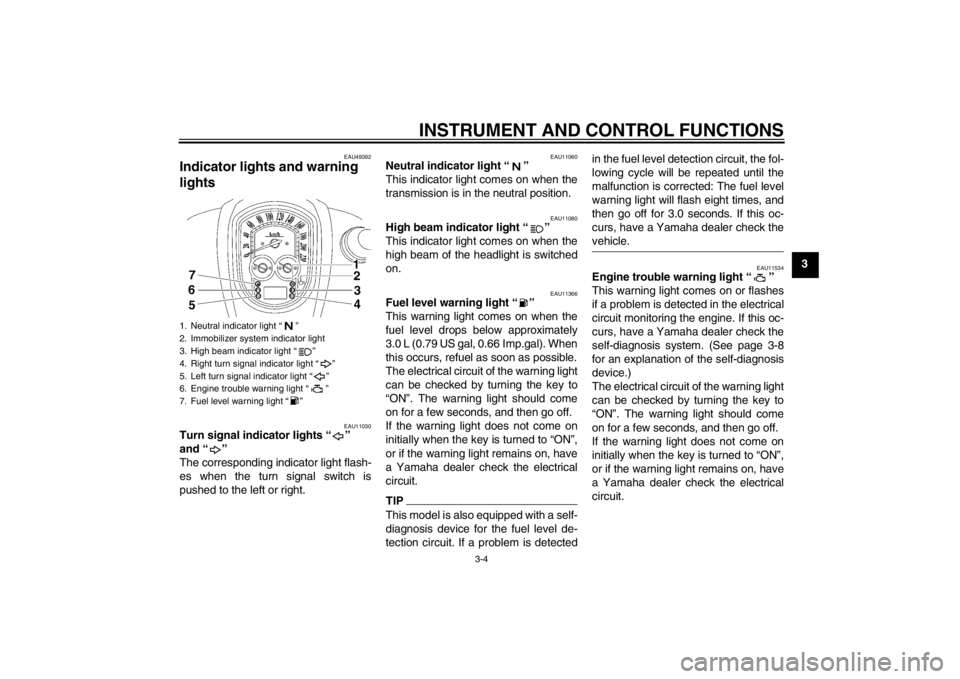
INSTRUMENT AND CONTROL FUNCTIONS
3-4
3
EAU49392
Indicator lights and warning
lights
EAU11030
Turn signal indicator lights “ ”
and “ ”
The corresponding indicator light flash-
es when the turn signal switch is
pushed to the left or right.
EAU11060
Neutral indicator light “ ”
This indicator light comes on when the
transmission is in the neutral position.
EAU11080
High beam indicator light “ ”
This indicator light comes on when the
high beam of the headlight is switched
on.
EAU11366
Fuel level warning light “ ”
This warning light comes on when the
fuel level drops below approximately
3.0 L (0.79 US gal, 0.66 Imp.gal). When
this occurs, refuel as soon as possible.
The electrical circuit of the warning light
can be checked by turning the key to
“ON”. The warning light should come
on for a few seconds, and then go off.
If the warning light does not come on
initially when the key is turned to “ON”,
or if the warning light remains on, have
a Yamaha dealer check the electrical
circuit.TIPThis model is also equipped with a self-
diagnosis device for the fuel level de-
tection circuit. If a problem is detectedin the fuel level detection circuit, the fol-
lowing cycle will be repeated until the
malfunction is corrected: The fuel level
warning light will flash eight times, and
then go off for 3.0 seconds. If this oc-
curs, have a Yamaha dealer check the
vehicle.
EAU11534
Engine trouble warning light “ ”
This warning light comes on or flashes
if a problem is detected in the electrical
circuit monitoring the engine. If this oc-
curs, have a Yamaha dealer check the
self-diagnosis system. (See page 3-8
for an explanation of the self-diagnosis
device.)
The electrical circuit of the warning light
can be checked by turning the key to
“ON”. The warning light should come
on for a few seconds, and then go off.
If the warning light does not come on
initially when the key is turned to “ON”,
or if the warning light remains on, have
a Yamaha dealer check the electrical
circuit.
1. Neutral indicator light “ ”
2. Immobilizer system indicator light
3. High beam indicator light “ ”
4. Right turn signal indicator light “ ”
5. Left turn signal indicator light “ ”
6. Engine trouble warning light “ ”
7. Fuel level warning light “ ”
U1CRE2E0.book Page 4 Monday, September 17, 2012 9:05 AM
Page 23 of 88
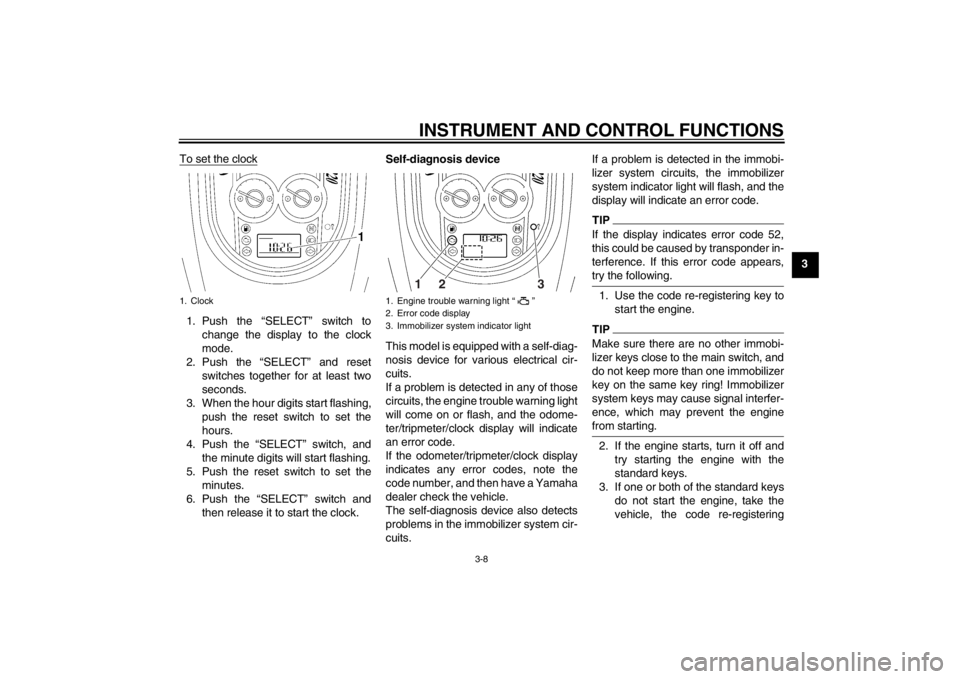
INSTRUMENT AND CONTROL FUNCTIONS
3-8
3
To set the clock
1. Push the “SELECT” switch to
change the display to the clock
mode.
2. Push the “SELECT” and reset switches together for at least two
seconds.
3. When the hour digits start flashing, push the reset switch to set the
hours.
4. Push the “SELECT” switch, and the minute digits will start flashing.
5. Push the reset switch to set the minutes.
6. Push the “SELECT” switch and then release it to start the clock. Self-diagnosis device
This model is equipped with a self-diag-
nosis device for various electrical cir-
cuits.
If a problem is detected in any of those
circuits, the engine trouble warning light
will come on or flash, and the odome-
ter/tripmeter/clock display will indicate
an error code.
If the odometer/tripmeter/clock display
indicates any error codes, note the
code number, and then have a Yamaha
dealer check the vehicle.
The self-diagnosis device also detects
problems in the immobilizer system cir-
cuits. If a problem is detected in the immobi-
lizer system circuits, the immobilizer
system indicator light will flash, and the
display will indicate an error code.
TIPIf the display indicates error code 52,
this could be caused by transponder in-
terference. If this error code appears,
try the following.1. Use the code re-registering key to
start the engine.TIPMake sure there are no other immobi-
lizer keys close to the main switch, and
do not keep more than one immobilizer
key on the same key ring! Immobilizer
system keys may cause signal interfer-
ence, which may prevent the engine
from starting.2. If the engine starts, turn it off andtry starting the engine with the
standard keys.
3. If one or both of the standard keys do not start the engine, take the
vehicle, the code re-registering
1. Clock
1. Engine trouble warning light “ ”
2. Error code display
3. Immobilizer system indicator light
1
2
3
U1CRE2E0.book Page 8 Monday, September 17, 2012 9:05 AM
Page 42 of 88
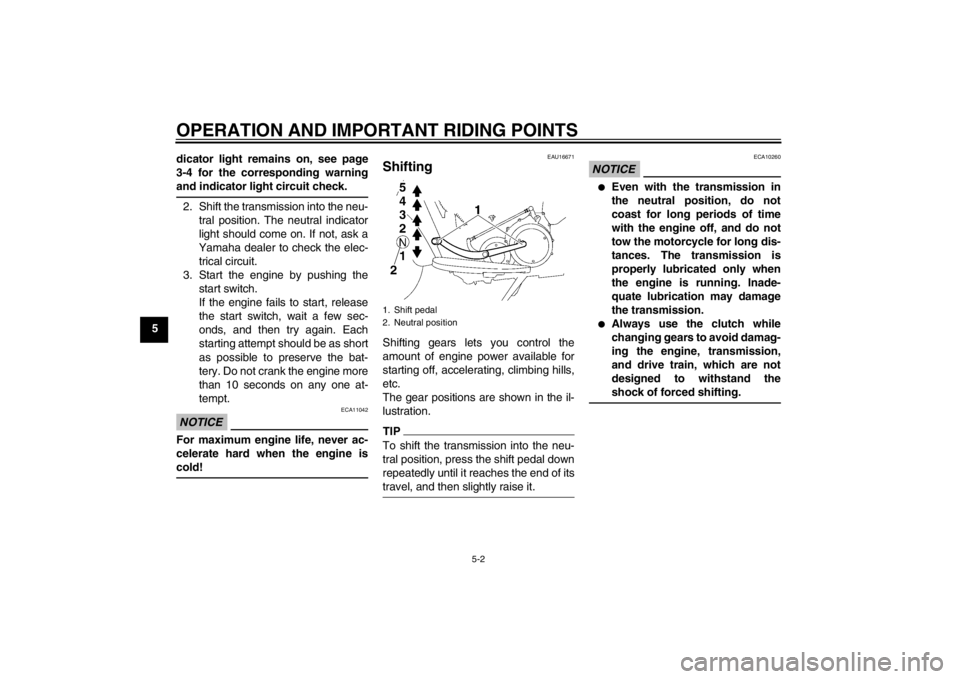
OPERATION AND IMPORTANT RIDING POINTS
5-2
5dicator light remains on, see page
3-4 for the corresponding warning
and indicator light circuit check.
2. Shift the transmission into the neu-
tral position. The neutral indicator
light should come on. If not, ask a
Yamaha dealer to check the elec-
trical circuit.
3. Start the engine by pushing the start switch.
If the engine fails to start, release
the start switch, wait a few sec-
onds, and then try again. Each
starting attempt should be as short
as possible to preserve the bat-
tery. Do not crank the engine more
than 10 seconds on any one at-
tempt.NOTICE
ECA11042
For maximum engine life, never ac-
celerate hard when the engine is
cold!
EAU16671
Shifting Shifting gears lets you control the
amount of engine power available for
starting off, accelerating, climbing hills,
etc.
The gear positions are shown in the il-
lustration.TIPTo shift the transmission into the neu-
tral position, press the shift pedal down
repeatedly until it reaches the end of its
travel, and then slightly raise it.
NOTICE
ECA10260
●
Even with the transmission in
the neutral position, do not
coast for long periods of time
with the engine off, and do not
tow the motorcycle for long dis-
tances. The transmission is
properly lubricated only when
the engine is running. Inade-
quate lubrication may damage
the transmission.
●
Always use the clutch while
changing gears to avoid damag-
ing the engine, transmission,
and drive train, which are not
designed to withstand the
shock of forced shifting.
1. Shift pedal
2. Neutral position
U1CRE2E0.book Page 2 Monday, September 17, 2012 9:05 AM
Page 43 of 88

OPERATION AND IMPORTANT RIDING POINTS
5-3
5
EAU16810
Tips for reducing fuel con-
sumption Fuel consumption depends largely on
your riding style. Consider the following
tips to reduce fuel consumption:●
Shift up swiftly, and avoid high en-
gine speeds during acceleration.
●
Do not rev the engine while shifting
down, and avoid high engine
speeds with no load on the engine.
●
Turn the engine off instead of let-
ting it idle for an extended length of
time (e.g., in traffic jams, at traffic
lights or at railroad crossings).
EAU16841
Engine break-in There is never a more important period
in the life of your engine than the period
between 0 and 1600 km (1000 mi). For
this reason, you should read the follow-
ing material carefully.
Since the engine is brand new, do not
put an excessive load on it for the first
1600 km (1000 mi). The various parts in
the engine wear and polish themselves
to the correct operating clearances.
During this period, prolonged full-throt-
tle operation or any condition that might
result in engine overheating must be
avoided.
EAU17113
0–1000 km (0–600 mi)
Avoid prolonged operation above 2500
r/min. NOTICE: After 1000 km (600
mi) of operation, the engine oil and
transfer case oil must be changed,
and the oil filter cartridge or element
replaced.
[ECA10892]
1000–1600 km (600–1000 mi)
Avoid prolonged operation above 3500
r/min.
1600 km (1000 mi) and beyond
The vehicle can now be operated nor-
mally.NOTICE
ECA10310
●
Keep the engine speed out of
the tachometer red zone.
●
If any engine trouble should oc-
cur during the engine break-in
period, immediately have a
Yamaha dealer check the vehi- cle.
U1CRE2E0.book Page 3 Monday, September 17, 2012 9:05 AM
Page 50 of 88

PERIODIC MAINTENANCE AND ADJUSTMENT
6-6
6
22*Rear suspension re-
lay arm and con-
necting arm
pivoting points Check operation.
√√√√
Lubricate with lithium-soap-based grease. √√
23 Engine oil Change.
Check oil level and vehicle for oil
leakage. √√√√√√
24 Engine oil filter car-
tridge Replace.
√√√
25 *Transfer case oil Check oil level.
√√
Change. √√√
26 *Front and rear brake
switches Check operation.
√√√√√√
27 Moving parts and
cables Lubricate.
√√√√√
28 *Throttle grip Check operation.
Check throttle grip free play, and
adjust if necessary.
Lubricate cable and grip housing. √√√√√
29 *Lights, signals and
switches Check operation.
Adjust headlight beam.
√√√√√√
NO. ITEM CHECK OR MAINTENANCE JOB
ODOMETER READING
ANNUAL
CHECK
1000 km
(600 mi) 10000 km
(6000 mi) 20000 km
(12000 mi) 30000 km
(18000 mi) 40000 km
(24000 mi)U1CRE2E0.book Page 6 Monday, September 17, 2012 9:05 AM
Page 52 of 88
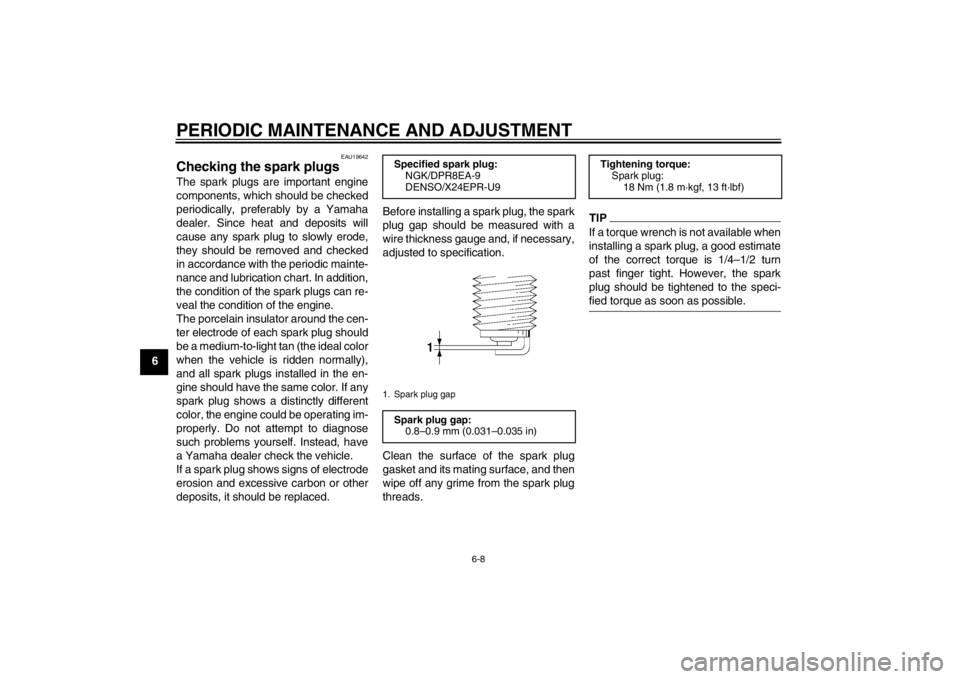
PERIODIC MAINTENANCE AND ADJUSTMENT
6-8
6
EAU19642
Checking the spark plugs The spark plugs are important engine
components, which should be checked
periodically, preferably by a Yamaha
dealer. Since heat and deposits will
cause any spark plug to slowly erode,
they should be removed and checked
in accordance with the periodic mainte-
nance and lubrication chart. In addition,
the condition of the spark plugs can re-
veal the condition of the engine.
The porcelain insulator around the cen-
ter electrode of each spark plug should
be a medium-to-light tan (the ideal color
when the vehicle is ridden normally),
and all spark plugs installed in the en-
gine should have the same color. If any
spark plug shows a distinctly different
color, the engine could be operating im-
properly. Do not attempt to diagnose
such problems yourself. Instead, have
a Yamaha dealer check the vehicle.
If a spark plug shows signs of electrode
erosion and excessive carbon or other
deposits, it should be replaced.Before installing a spark plug, the spark
plug gap should be measured with a
wire thickness gauge and, if necessary,
adjusted to specification.
Clean the surface of the spark plug
gasket and its mating surface, and then
wipe off any grime from the spark plug
threads.
TIPIf a torque wrench is not available when
installing a spark plug, a good estimate
of the correct torque is 1/4–1/2 turn
past finger tight. However, the spark
plug should be tightened to the speci-
fied torque as soon as possible.
Specified spark plug:
NGK/DPR8EA-9
DENSO/X24EPR-U91. Spark plug gapSpark plug gap:0.8–0.9 mm (0.031–0.035 in)
Tightening torque:Spark plug:
18 Nm (1.8 m·kgf, 13 ft·lbf)
U1CRE2E0.book Page 8 Monday, September 17, 2012 9:05 AM
Page 53 of 88
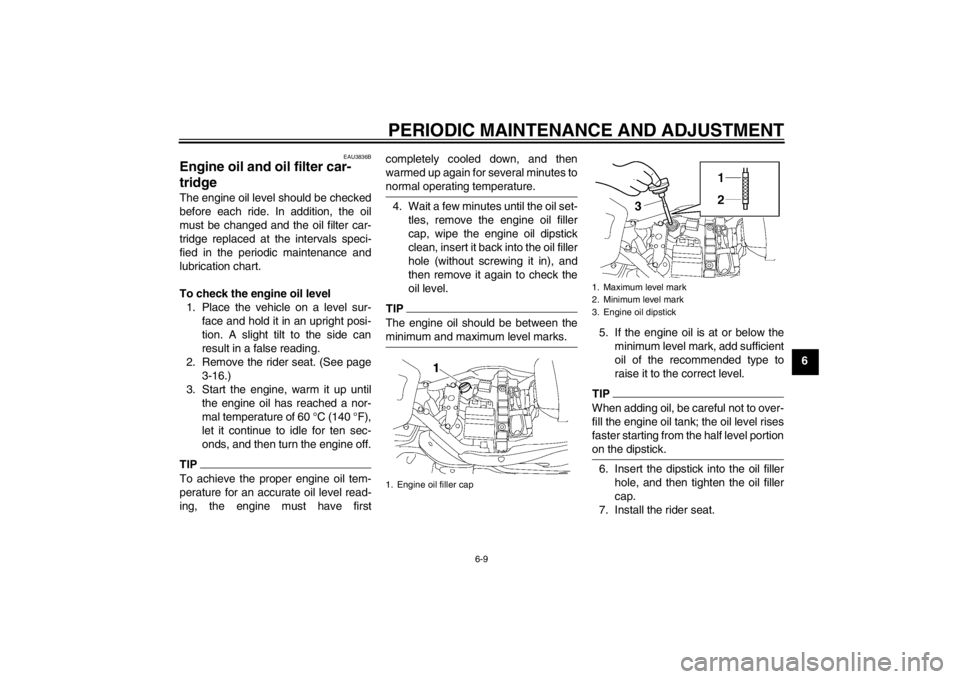
PERIODIC MAINTENANCE AND ADJUSTMENT
6-9
6
EAU3836B
Engine oil and oil filter car-
tridge The engine oil level should be checked
before each ride. In addition, the oil
must be changed and the oil filter car-
tridge replaced at the intervals speci-
fied in the periodic maintenance and
lubrication chart.
To check the engine oil level1. Place the vehicle on a level sur- face and hold it in an upright posi-
tion. A slight tilt to the side can
result in a false reading.
2. Remove the rider seat. (See page 3-16.)
3. Start the engine, warm it up until the engine oil has reached a nor-
mal temperature of 60 °C (140 °F),
let it continue to idle for ten sec-
onds, and then turn the engine off.TIPTo achieve the proper engine oil tem-
perature for an accurate oil level read-
ing, the engine must have first completely cooled down, and then
warmed up again for several minutes to
normal operating temperature.
4. Wait a few minutes until the oil set-
tles, remove the engine oil filler
cap, wipe the engine oil dipstick
clean, insert it back into the oil filler
hole (without screwing it in), and
then remove it again to check the
oil level.TIPThe engine oil should be between the
minimum and maximum level marks.
5. If the engine oil is at or below theminimum level mark, add sufficient
oil of the recommended type to
raise it to the correct level.TIPWhen adding oil, be careful not to over-
fill the engine oil tank; the oil level rises
faster starting from the half level portion
on the dipstick.6. Insert the dipstick into the oil fillerhole, and then tighten the oil filler
cap.
7. Install the rider seat.
1. Engine oil filler cap
1. Maximum level mark
2. Minimum level mark
3. Engine oil dipstick
U1CRE2E0.book Page 9 Monday, September 17, 2012 9:05 AM
Page 74 of 88
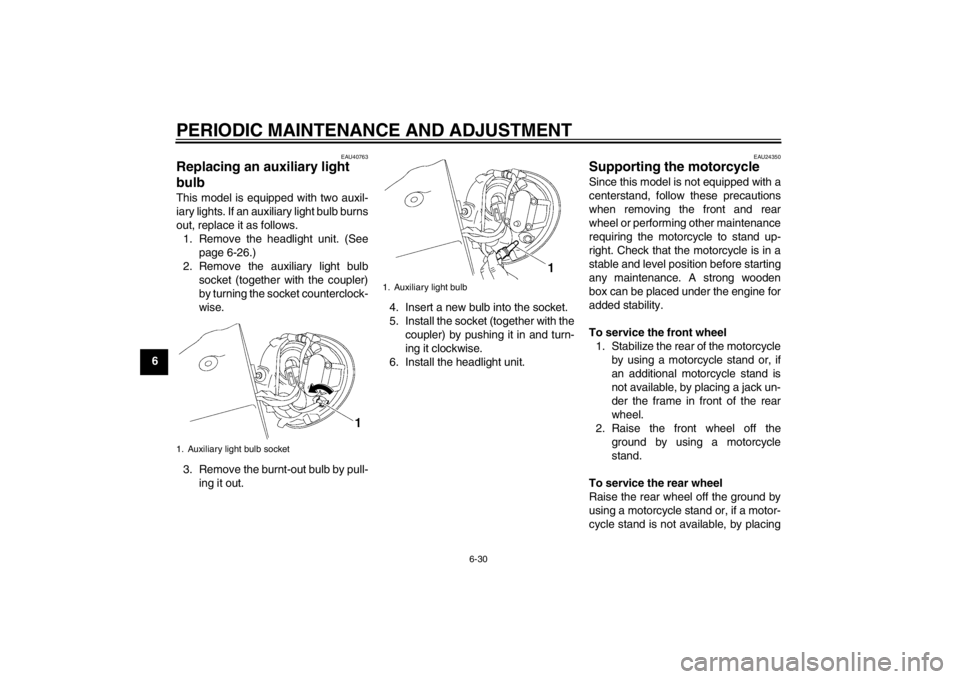
PERIODIC MAINTENANCE AND ADJUSTMENT
6-30
6
EAU40763
Replacing an auxiliary light
bulb This model is equipped with two auxil-
iary lights. If an auxiliary light bulb burns
out, replace it as follows.1. Remove the headlight unit. (See page 6-26.)
2. Remove the auxiliary light bulb socket (together with the coupler)
by turning the socket counterclock-
wise.
3. Remove the burnt-out bulb by pull- ing it out. 4. Insert a new bulb into the socket.
5. Install the socket (together with the
coupler) by pushing it in and turn-
ing it clockwise.
6. Install the headlight unit.
EAU24350
Supporting the motorcycle Since this model is not equipped with a
centerstand, follow these precautions
when removing the front and rear
wheel or performing other maintenance
requiring the motorcycle to stand up-
right. Check that the motorcycle is in a
stable and level position before starting
any maintenance. A strong wooden
box can be placed under the engine for
added stability.
To service the front wheel 1. Stabilize the rear of the motorcycle by using a motorcycle stand or, if
an additional motorcycle stand is
not available, by placing a jack un-
der the frame in front of the rear
wheel.
2. Raise the front wheel off the ground by using a motorcycle
stand.
To service the rear wheel
Raise the rear wheel off the ground by
using a motorcycle stand or, if a motor-
cycle stand is not available, by placing
1. Auxiliary light bulb socket
1. Auxiliary light bulb
U1CRE2E0.book Page 30 Monday, September 17, 2012 9:05 AM